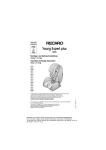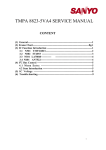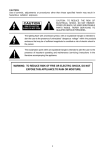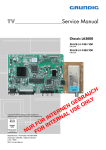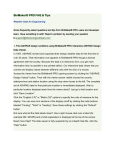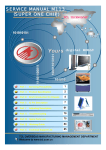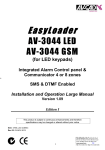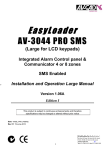Download DISTAR SERVICE MANUAL
Transcript
ELENBERG 2910F, CAMERON STV-2937 DISTAR SERVICE MANUAL DT-2977 1. Caution……………………………………………………………2 2. Specification………………………………………………………6 3. BOM List ……………………… …………………………………9 4. Alignment Procedure………………………………………….…35 5. Block Diagram……………………………………………………39 6. Schematic Diagram………………………………………………40 7. PCB Layout………….……………………………………………41 8. Explode View Diagram……………………………………………43 This manual is the latest at the time of printing, and does not include the modification which may be made after the printing, by the constant improvement of product. TCL M113A chassis alignment instruction Enter factory mode in production line Simply press the D-mode key on the factory remote handset. Enter service mode Press and hold the VOLUME DOWN key tightly on the unit until minimum level and don’t release the VOLUMN DOWN key, then press the DISPLAY key on the remote handset. “D” letter on the screen indicated that the factory mode was entered. Now you can use the shortcut key to access the factory menu. All change in factory data will save in EEPROM automatically Note: 1. You can disable the D-Mode key (on factory remote handset) by change “BIT-0” of “OPT” to “0”. If the D-Mode key was disabled, you can’t enter D-Mode by the D-mode key on the factory remote (but you can still enter service mode). It is suggested to disable the D-Mode key before the set leave the factory. 2. On the factory remote handset, you can find the “I²C” key. It can cut off the I2C control from the CPU to other IC. This is only useful when automatic adjustment of white balance. 3. All system data in menu of “key 6” must keep unchanged when servicing. Otherwise, the set may not work properly. Setting method: No Adjustment Data Name (default Conditions and Setting method (need enter D-mode) Items value inside blanket) input signal 1 Screen -----------“IRGB cut off” Press “MUTE” key on the remote handset voltage must set to 80 (all and the screen will become a horizontal pattern) line. Then adjust the “screen” VR on the flyback until the horizontal line can just be seen (minimum visible intensity). 2 Focus voltage ------------ 3 HIT(11) VP50(04) VLIN(0B) VSC(09) VBLK(00) VCEN(1B) OSDH(1F) DPC43(00) Vertical geometry for PAL system (Key 1) Cross hatch pattern. Adjust the “focus” VR on the flyback until the screen becomes clear. Input a PAL cross Adjust HIT for vertical amplitude. hatch pattern. Adjust VP50 for vertical position. Adjust VLIN for vertical linearity. Adjust VSC for vertical S-correction (Normally use default value) Adjust VCEN for vertical position Adjust OSDH for OSD position Same as DPC, adjust it on EXPAND 4:3 mode. Input a NTSC cross hatch pattern. 4 Vertical geometry for NTSC system (Key 1) HITS(11) VP60(02) VLIS(0A) VSS(08) VBLK(00) VCEN(1C) OSDHS(1D) DPC43S(00) 5 Horizontal geometry for PAL system (Key 2) HPOS(0C) DPC(23) KEY(20) WID(22) ECCT(09) ECCB(0A) VEHT(04) HEHT(04) Input a PAL cross hatch pattern with black and white background. 6 Horizontal geometry for NTSC system (Key 2) HPS (10) DPCS(1F) KEYS(1F) WIDS(22) ECCTS(0E) ECCBS(10) VEHTS(04) HEHTS(04) Input a NTSC cross hatch pattern with black and white background. 7 Key 3 (Status adjustment) 8 Key 4 (Status adjustment) CNTX (5A) CNTN (07) BRTX (20) BRTN (1D) COLX (3F) COLN (00) TNTX (42) TNTN (28) BRTC (30) COLC (57) COLS (47) COLP (F0) SCOL(04) SCNT (0F) CNTC (40) TNTC (48) Adjust HITS for vertical amplitude. Adjust VP60 for vertical position. Adjust VLINS for vertical linearity. Adjust VSS for vertical S-correction (normally use default value) Adjust VCEN for vertical position. Adjust OSDHS for OSD position Same as DPC, adjust it on EXPAND 4:3 mode. Adjust HPOS for horizontal position. Adjust DPC, KEY, ECCT and ECCB until the vertical line at left and right side of the picture become straight. Adjust WID for horizontal width. VEHT and HENT is for the picture size stability when changing the brightness of the screen. Receive pattern of cross hatch with black background and then change to white background, then compare the vertical and horizontal size between black and white background. Adjust VEHT and HEHT until you get the minimum difference of screen size. After you adjust VEHT and HEHT, you must re-adjust vertical and horizontal amplitude. Adjust HPS for horizontal position. Adjust DPCS, KEYS, ECCTS and ECCBS until the vertical line at left and right side of the picture become straight. Adjust WIDS for horizontal width. Adjust VEHTS and HEHTS using same method of PAL system. Also need re-adjustment of vertical and horizontal amplitude. ---------- (all use default value) ---------- (all use default value) 9 Key 5 (sharpness adjustment) 10 Key 7 (Status adjustment) 11 Key 8 (curve of volume control, curve of B.E./WOOFER) 12 Key 9 (curve of B.E./WOOFER) 13 Key calendar (other adjustment) 14 Key note (other adjustment) ST3 (20) SV3 (20) ST4 (20) SV4 (20) SVD(15) ASSH(04) SHPX (3F) SHPN (1A) RFAGC (1A) SBY (08) SRY (08) BRTS (0D) TXCX (1F) RGCN (00) SECD(08) MUTT(20) STAT(60) V01(3A) V25(B0) V50(DC) V100(FF) BASC(40) BASX(72) TREC(40) WOFC(39) AVC(0E) NEWS(14) SPACES(5A) NEWT(14) SPACET(5A) WOFF(00) B01(4F) B25(68) B50(7F) SVM(05) SVM1(05) SVM2(05) SVM3(05) PYNX(28) PYNN(15) PYXS(22) PYNS(04) CLTO(4B) CLTM(4C) CLVO(4D) CLVD(48) ABL(27) DCBS(33) DEF(01) ---------- (all use default value) Receive a 60dB Adjust RFAGC until the picture noises grey scale + disappear exactly. color bar signal Adjust SBY and SRY to get the optimal color for SECAM system. For the adjustment of BRTS, receive an 8 step grey scale pattern and adjust all picture settings to 50%. Then adjust BRTS until the first and second step on the screen can just be distinguished. (the other use default value) --------- (all use default value) ---------- (all use default value) ---------- (all use default value) ---------- (all use default value) 15 Key game (other adjustment) 16 Key 0 (White balance adjustment) OSD1(2B) OSDF1(63) OSD2(1C) OSDF2(63) HAFC(09) NOIS(01) UCOM(00) R CUT (80) G CUT (80) B CUT (80) G DRV (40) B DRV (40) ---------- (all use default value) Black and white 1. Measure the dark side of the picture with pattern (PAL) a color analyzer and set RCUT to 80. Then adjust BCUT and GCUT until the data on the analyzer become x = 284, y = 299. 2. Measure the bright side of the picture, Then adjust BDRV and GDRV until the data on the analyzer become x = 284, y = 299. 3. Repeat step 1 and 2 until you get right color on both dark and bright side of the screen. System data: Item Key6 Adjust item OPT FLG0 FLG1 STBY HD-DELAY MODE0 MODE1 MODE2 Default value 36 02 CD 12 0C A2 D7 0C FACTORY-OUT SETUP:In D-MODE, press RECALL button to initialize to the FACTORY-OUT status. AGING MODE: In D-MODE, press OK button to entry AGING MODE. EEPROM INITIALZATION: In D-MODE, press “0752” to initialize EEPROM. NOTICE: Before to be released, any M113A chassis must be initialized to the FACTORY-OUT status. Don’t try to initialize EEPROM, unless software can’t work normally.








